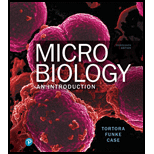
In August, a 24-year-old man from Virginia developed difficulty breathing and bilateral lobe infiltrates 2 months after driving through California. During initial evaluation, typical pneumonia was suspected, and he was treated with antibiotics. Efforts to diagnose the pneumonia were unsuccessful. In October, a laryngeal mass was detected, and laryngeal cancer was suspected; treatment with steroids and bronchodilators did not result in improvement. Lung biopsy and laryngoscopy detected diffuse granular tissue. He was treated with amphotericin B and discharged after 5 days. What was the disease? What might have been done differently to decrease the patient’s recovery time from 3 months to 1 week?
Want to see the full answer?
Check out a sample textbook solution
Chapter 24 Solutions
Microbiology: An Introduction (13th Edition)
Additional Science Textbook Solutions
Campbell Biology in Focus
Principles of Anatomy and Physiology
Human Physiology: An Integrated Approach (8th Edition)
Brock Biology of Microorganisms (15th Edition)
Anatomy & Physiology (6th Edition)
Campbell Essential Biology (7th Edition)
- A 45-year-old man complains of swelling of the neck and difficulty of breathing of 10-day duration. He has noticed some nasal stuffiness with hoarseness of his voice for about 3 weeks and had attributed these symptoms to an upper respiratory infection. He denies the use of alcohol but has smoked two packs of cigarettes per day for 32 years. Lately, he feels as though something is pushing against his throat. On physical examination, the patient’s face appears ruddy and swollen. The jugular veins are distended. What is the most likely diagnosis?What is the most likely cause?What are the anatomical structures involved?arrow_forwardLF, a 34 year old white male, presented to the emergency room complaining of acute and severe shortnessof breath and intense chest tightness. LF’s speech was choppy and breathing was very rapid and erratic,punctuated by noticeable wheezing. LF’s medical records included the results of pulmonary functiontesting he had undergone six months beforeHis medical records also indicated prior admission for respiratory symptoms and a history of poorly-controlled asthma.LF received high-dose bronchodilator medication through use of a valved holding chamber. This wasfollowed by intravenous glucocorticoids and nebulized bronchodilators every two hours for a twelve-hourperiod, followed by nebulized bronchodilators every four hours for a forty-eight hour period.After discharge from the hospital, LF was provided a take-home flow meter to monitor his lung function.Table 4 shows LF’s PEFR results during a 30-day period.Table 4. Peak flow monitoring from day 1-30 post-discharge. All PEFR values are given…arrow_forwardDon Paladio had been a pharmacist in New York City. He retired to Florida and spent the better part of everyday swimming in the Gulf. He was healthy and strong. Gradually, however, his years of smoking began to compromise his lung's capacity. Soon, he could not swim at all. He enjoyed the beach from under his umbrella. Eventually, the trips to the beach were not possible. The diagnosis was pulmonary emphysema and COPD. Oxygen was needed, and his activities were diminished to cooking dinner for his wife and himself. Don was embarrassed about the oxygen tank and would no longer go out in public. He died when he was 85. 1.Discuss the impact of both diseases in Don's life 2.What, if anything, could have been done to make his suffering less difficult? 3.Identify characteristics of such long-term chronic illnesses that are particularly difficult. ***INCLUDE CITATIONS IN MLA 9TH EDITION PERDUE OWL***arrow_forward
- 1.) When the patient was in the emergency department, what pulmonary function measurement served as an important clinical indicator of the severity of the patient’s asthma attack? 2.) This patient demonstrated both obstructive and restrictive lung disorders. During the first part of the case, which pulmonary function studies verified that the patient had an obstructive pulmonary disorder?arrow_forwardState 4 diagnostic tests for respiratory conditions and 4 signs and symptoms associated with respiratory conditionsarrow_forwardLower respiratory tract infection includes pneumonia, bronchitis and tuberculosis. Identify SIX (6) symptoms of severe lung infections.arrow_forward
- After traveling by air from Romania to New York, a 35-year-old woman develops a sudden onset of chest pain and shortness of breath. She has not experienced anything like this before, but her sister had a similar episode after the delivery of her first child. On examination, the patient appears anxious and tachypneic. Her lungs reveal good air movement bilaterally. What is the most likely diagnosis? What are the possible underlying mechanisms? What are the risk factors?arrow_forwardExplain the pathophysiology tension pneomothorax and support the clinical presentation of decreased air entry and hyperinflation of the right chest wall in a patient who was stabbed to the right anterior chest.arrow_forwardCase one Respiratory issue After traveling by air from Romania to New York, a 35-year-old woman develops a sudden onset of chest pain and shortness of breath. She has not experienced anything like this before, but her sister had a similar episode after the delivery of her first child. On examination, the patient appears anxious and tachypneic. Her lungs reveal good air movement bilaterally. Questions What is the most likely diagnosis? What are the possible underlying mechanisms? What are the risk factors?arrow_forward
- A 65-year-old man with a 40-year history of tobacco use and a chronic productive cough for several years develops more severe dyspnea and fever. He has an enlarged chest diameter and some mild blueness to the lips. A chest radiograph shows an enlarged heart and hyperlucent lung fields but no evidence of a pulmonary infiltrate. What is the most likely diagnosis? 2. What is the most likely underlying mechanism associated with this disorder?arrow_forwardCompare the causative organism and two significant signsof lobar pneumonia with those of bronchopneumonia.arrow_forwardIs lung transplantation a solution for emphysema?arrow_forward
- Basic Clinical Lab Competencies for Respiratory C...NursingISBN:9781285244662Author:WhitePublisher:CengageEssentials of Pharmacology for Health ProfessionsNursingISBN:9781305441620Author:WOODROWPublisher:Cengage


